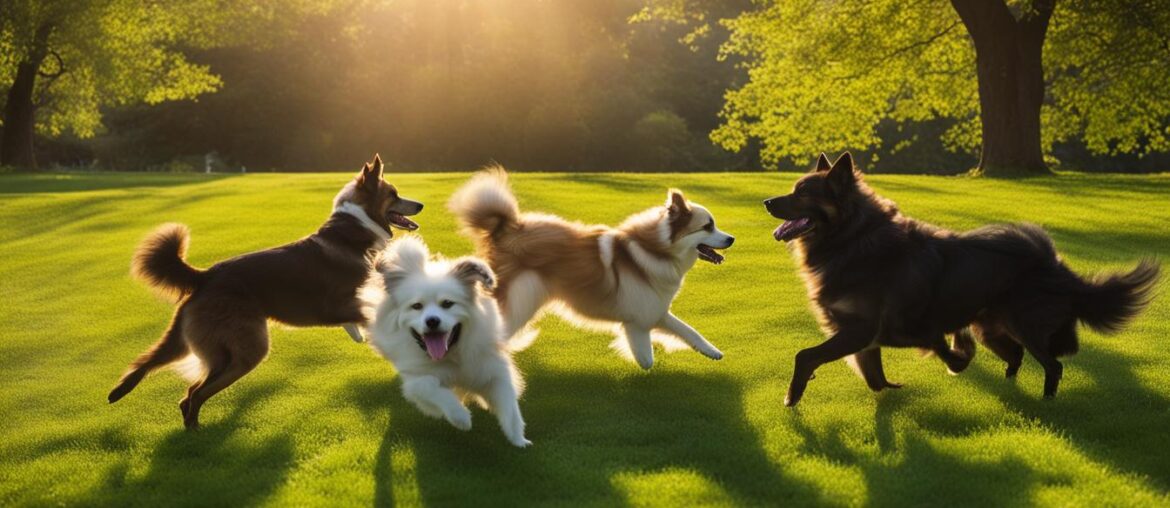As a dog lover, I’ve always been fascinated by the unique characteristics and traits that different dog breeds possess. One feature that catches my attention is a curly tail. From the adorable Samoyed to the spirited Basenji, there are several dog breeds with curly tails that add to their charm and appeal.
Dog tails are not just a decorative feature, but they serve various purposes for our furry friends. They help with balance, communication, and even provide warmth in cold climates. So, let’s embark on a tail-wagging tour and explore five dog breeds that sport beautifully curled tails.
Key Takeaways:
- Curly tailed dog breeds have tails that are not only visually appealing but also serve important functions for the dogs.
- The Samoyed, Basenji, Akita, Shiba Inu, and Chihuahua are some of the dog breeds that have curly tails.
- Each breed has its own unique traits and characteristics, making them suitable for different lifestyles and preferences.
- Other dog breeds like the Pug, Finnish Spitz, Chow Chow, Keeshond, Norwegian Elkhound, American Eskimo Dog, and Alaskan Malamute also have curly tails.
- If you’re looking for a new furry companion, consider one of these curly tailed breeds for their charm, loyalty, and history.
Samoyed
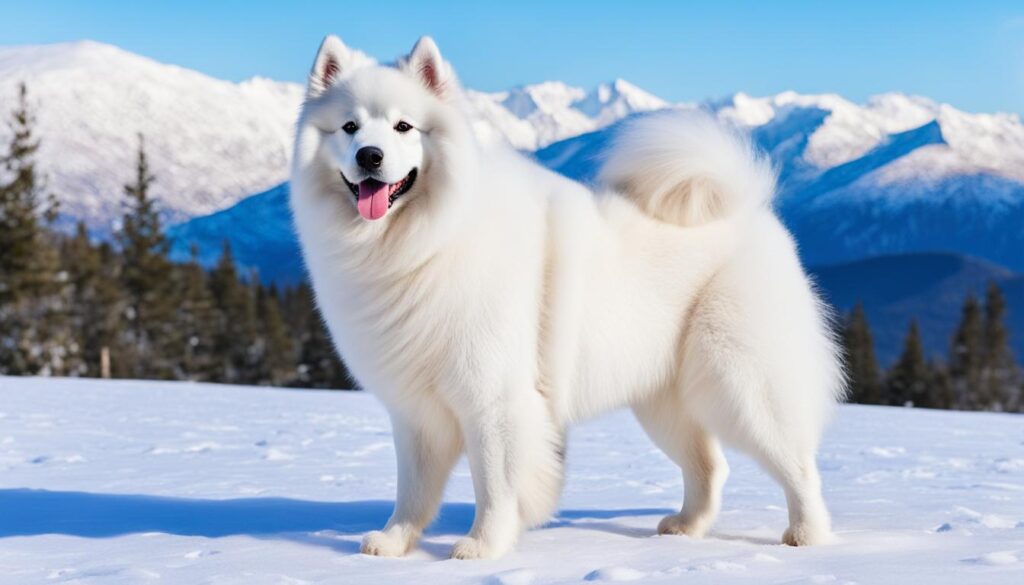
The Samoyed is a well-known arctic breed with a beautifully curled tail that swirls forward over its back. These dogs were developed by the Samoyede people to work in Siberia, hunting, herding reindeer, and hauling sleds. Their thick tails are particularly useful in cold climates, as they can be used to cover their noses while sleeping outside.
The Samoyed is a versatile and friendly breed that makes an excellent family pet. Known for their gentle disposition and love for children, Samoyeds are often referred to as “smiling dogs” due to their perpetually happy expressions. They are also highly intelligent and have a strong desire to please their owners, making them relatively easy to train.
In addition to their curly tails, Samoyeds have a dense double coat that keeps them warm in cold weather. However, this luxurious coat requires regular grooming to prevent matting and shedding. Their friendly nature, striking appearance, and fluffy tails make Samoyeds a popular choice for dog enthusiasts worldwide.
Basenji
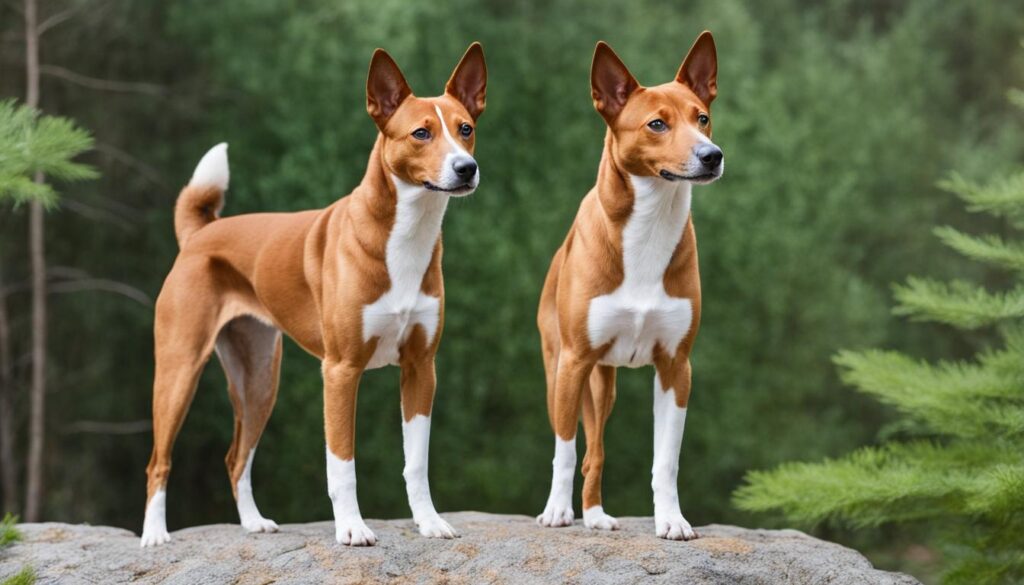
The Basenji is an ancient hunting breed from Africa known for its unique vocalizations and curly tail. While they are often referred to as a bark-less breed, they do make other sounds. Basenjis have tails that bend forward and curl over to one side or the other. They are agile hunters and have a distinctive appearance with almond-shaped eyes and wrinkled foreheads.
Originating from Central Africa, the Basenji is one of the oldest known dog breeds. They were highly valued by African tribes for their hunting skills and ability to navigate dense forests. Basenjis have a short, sleek coat that comes in a variety of colors, including red, black, and brindle. Their curly tails are an enchanting feature that adds to their graceful and exotic appearance.
Basenjis are intelligent, independent, and active dogs. They have a strong prey drive and require regular exercise and mental stimulation to prevent boredom. Due to their hunting instincts, Basenjis may not always get along well with small animals, so caution should be exercised when introducing them to other pets.
Despite their small to medium size, Basenjis have a confident and spirited nature. They are known for their cat-like behavior, as they are meticulous groomers and enjoy climbing and perching on high surfaces. Basenjis also tend to be aloof with strangers but form strong bonds with their family members.
To properly care for a Basenji, regular exercise and mental enrichment are crucial. They excel in activities such as obedience training, agility, and lure coursing. Basenjis are generally healthy dogs, but they can be prone to certain genetic conditions, including Fanconi syndrome and progressive retinal atrophy.
If you’re considering adding a Basenji to your family, it’s important to research and find a reputable breeder who prioritizes the health and well-being of their dogs. Basenjis can be a wonderful companion for experienced dog owners who appreciate their unique traits and are committed to meeting their exercise and training needs.
Akita

The Akita is a large and powerful Japanese breed with a plush and curled tail. As puppies, their tails start straight but gradually curl into a tight “flip.” The curl of their tails can vary depending on their mood, with tighter curls when they are alert or excited. Akitas are fearless and loyal dogs, originally developed as versatile hunting and guard dogs.
If you’re looking for a devoted companion with a distinctive curly tail, the Akita is a breed worth considering. Their curly tails not only add to their visual appeal but also serve as a reflection of their strong and resilient nature. Whether they’re wagging their tails in excitement or using them to communicate, Akitas display a captivating elegance that sets them apart from other breeds.
Shiba Inu
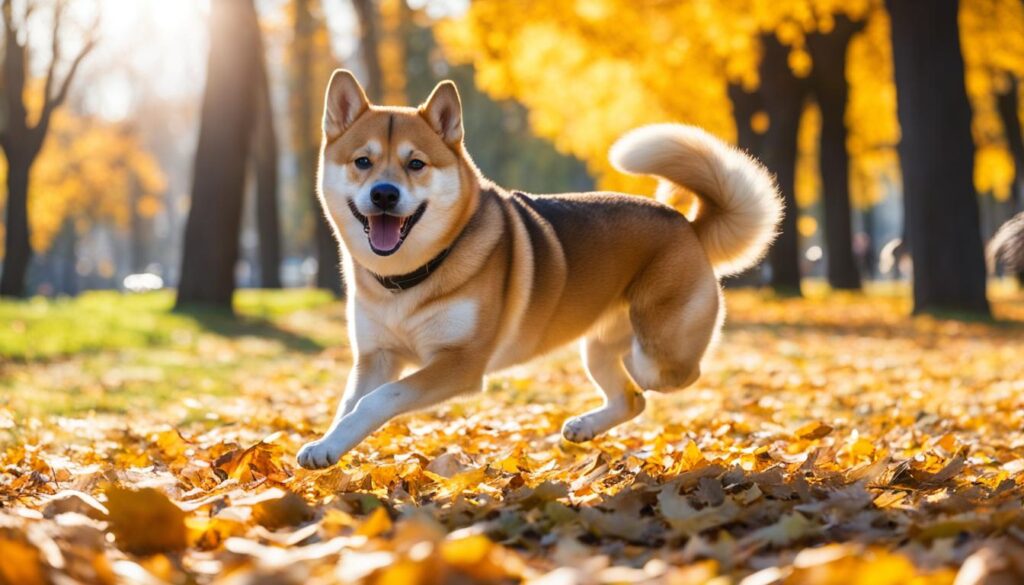
The Shiba Inu is another ancient Japanese breed with a distinctive curled tail. These dogs were bred to hunt in wild shrubs and brush, and their tails play a role in balancing their small yet sturdy bodies. The hair on their tails is slightly longer than the rest of their coat, adding to their overall elegance and grace.
Characteristics of the Shiba Inu breed:
- Size: The Shiba Inu is a small to medium-sized dog, typically weighing between 17 to 23 pounds (7.7 to 10.4 kilograms).
- Appearance: They have a compact and muscular build, with a fox-like face, erect ears, and a curled tail.
- Coat: Shiba Inus have a double coat with a thick, straight outer layer and a soft, dense undercoat. They come in various colors, including red, sesame, black and tan, and cream.
- Temperament: These dogs are known for their spirited and independent nature. They are intelligent, alert, and loyal to their families.
- Exercise needs: Shiba Inus are active dogs that require daily exercise to stay happy and healthy. Regular walks, playtime, and mental stimulation are important for their well-being.
- Training: Shiba Inus are intelligent but can be stubborn. Consistent and positive reinforcement training methods work best with this breed.
- Grooming: They have a self-cleaning coat and only require occasional brushing to keep it in good condition. However, they shed heavily twice a year.
Despite their small size, Shiba Inus have a confident and bold personality. They make excellent companions for experienced dog owners who can provide them with the structure, training, and mental stimulation they need. Their distinctive curled tails add to their allure and make them stand out in the canine world.
| Shiba Inu | Samoyed | Basenji |
|---|---|---|
| Origin: Japan | Origin: Siberia | Origin: Africa |
| Size: Small to medium | Size: Large | Size: Small to medium |
| Coat: Double coat, various colors | Coat: Double coat, white | Coat: Short, various colors |
| Temperament: Spirited, independent | Temperament: Friendly, gentle | Temperament: Intelligent, alert |
| Exercise needs: Moderate | Exercise needs: High | Exercise needs: Moderate |
Chihuahua
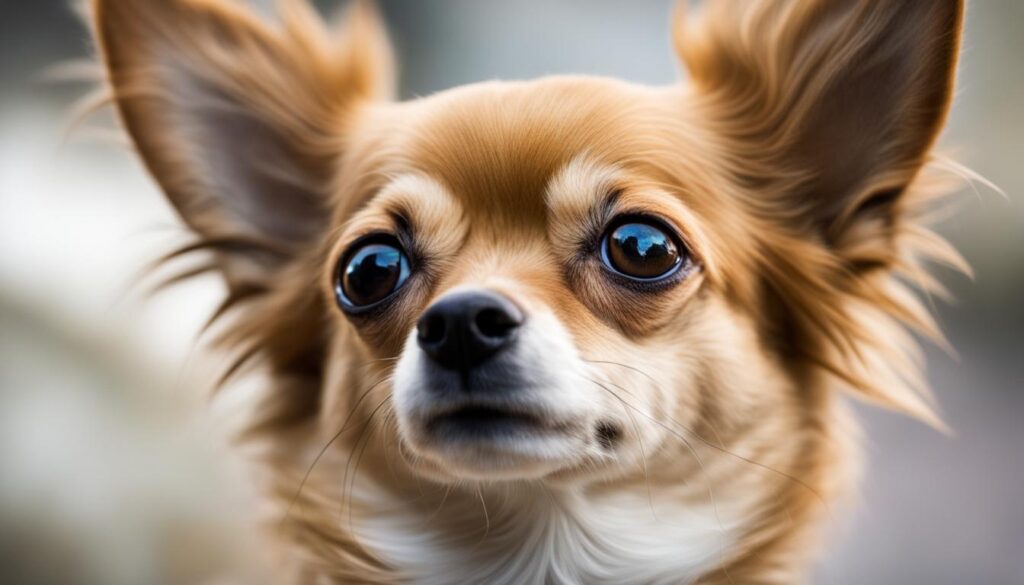
The Chihuahua, a small breed originating from Mexico, also sports a curly tail. Unlike other dog breeds with curly tails, Chihuahuas don’t require their tails to cover their noses for warmth. Their tails are carried in a sickle or slightly open curve, giving them an added touch of beauty. These dogs were considered sacred by the Aztecs and are known for their lively and affectionate personalities.
Chihuahua Highlights:
- Originating from Mexico
- Curls their tail in a sickle or slightly open curve
- Don’t require their tails for warmth like some other curly tailed breeds
- Considered sacred by the Aztecs
- Lively and affectionate personalities
Pug
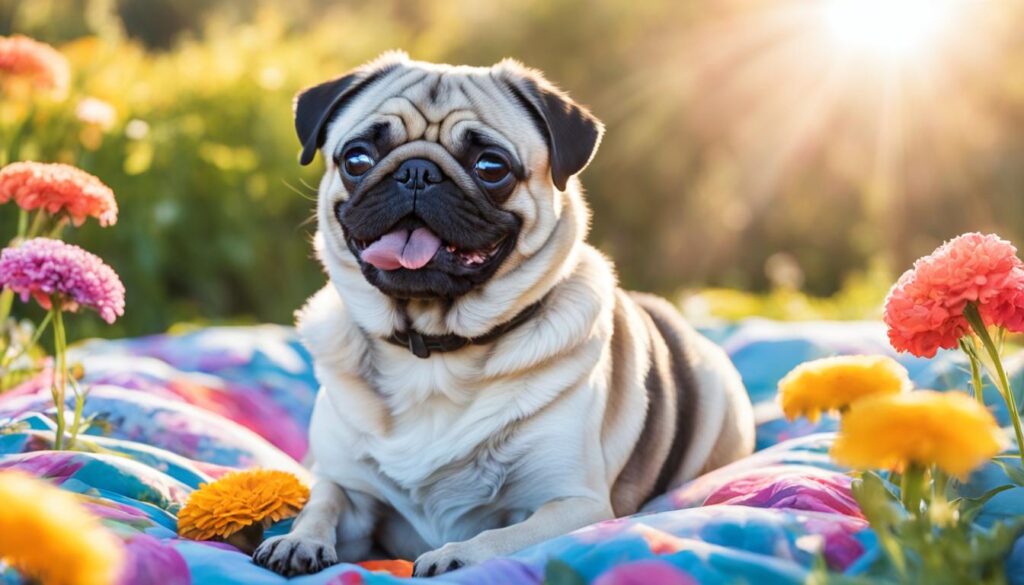
Pugs are instantly recognizable by their squished faces, and they also have curly tails. These small dogs were bred to be companions and are known for their boisterous personalities. Their curly tails contribute to their overall cuteness and add to their expressive nature. Pugs are affectionate, adaptable, and make great pets for city dwellers.
Characteristics of Pugs:
| Traits | Description |
|---|---|
| Size | Pugs are small dogs, typically weighing between 14-18 pounds. |
| Appearance | They have a stocky build, a wrinkled face, and a short, smooth coat. |
| Temperament | Pugs are known for their friendly and outgoing nature. They get along well with children and other pets. |
| Exercise | While they aren’t high-energy dogs, Pugs still enjoy daily walks and playtime to maintain a healthy weight. |
| Health | Pugs are prone to certain health issues, including obesity, breathing problems, and eye conditions. |
If you’re considering adding a Pug to your family, be prepared for lots of love and laughs. These adorable dogs will steal your heart with their curly tails and endearing personality.
Other Dog Breeds with Curly Tails
In addition to the aforementioned breeds, there are several other dog breeds with curly tails. These include the Finnish Spitz, Chow Chow, Keeshond, Norwegian Elkhound, American Eskimo Dog, and Alaskan Malamute. Each of these breeds has its own unique characteristics, and their curly tails only add to their appeal.
Curly Tailed Dog Breeds
- Finnish Spitz
- Chow Chow
- Keeshond
- Norwegian Elkhound
- American Eskimo Dog
- Alaskan Malamute
Let’s take a closer look at these breeds:
| Breed | Characteristics |
|---|---|
| Finnish Spitz | The Finnish Spitz is a medium-sized breed with a dense double coat, pointed ears, and a distinctive curled tail. Known for their fox-like appearance, they are energetic and playful companions. |
| Chow Chow | The Chow Chow, with its thick fur and curled tail, is a dignified and independent breed. They have a unique blue-black tongue and can be aloof towards strangers while remaining deeply loyal to their families. |
| Keeshond | Keeshonds are known for their luxurious black, gray, and cream coats and fluffy curled tails. They are friendly, intelligent, and make excellent family pets. |
| Norwegian Elkhound | The Norwegian Elkhound is a sturdy and protective breed with a curved tail that rests over its back. They have a thick gray coat that provides insulation in cold weather and were originally used for hunting elk and other game. |
| American Eskimo Dog | The American Eskimo Dog, contrary to its name, is not from Alaska but was bred in the United States. They have a beautiful white coat, alert expression, and a plumed tail that forms a tight curl over their backs. |
| Alaskan Malamute | The Alaskan Malamute is a powerful sled dog with a dense double coat and a curled tail that rests over its back. They are friendly, loyal, and thrive in colder climates. |
These curly tailed dog breeds offer a diverse range of appearances, temperaments, and histories. Whether you’re looking for a spitz-type companion, a noble and independent companion, or a resilient working dog, these breeds with curly tails have something to offer.
Next, let’s conclude our tail-wagging tour and summarize what we’ve learned about these delightful dog breeds with curly tails.
Wrapping Up
Curly tailed dog breeds are not only visually captivating but also boast a captivating history and a diverse range of traits. Each breed, from the arctic beauty of the Samoyed to the spirited Basenji, brings its own unique charm to the table. Whether you’re seeking a loyal family companion, a hunting partner, or a faithful friend, these curly tailed breeds offer a variety of options to suit different preferences.
The Samoyed, with its beautifully curled tail, is a well-known arctic breed that thrives in cold climates. Developed by the Samoyede people for hunting and herding, their tails also double as a protective cover while they sleep outside. On the other hand, the Basenji, known for its vocalizations, has a distinctive curled tail that bends forward and curls to one side or the other. This ancient African hunting breed is agile and carries an unmistakable air of elegance.
The Akita, a large and powerful Japanese breed, possesses a plush curled tail that gradually forms a tight “flip” as they grow. These fearless and devoted dogs were originally bred for hunting and guarding. Meanwhile, the Shiba Inu, another Japanese breed, showcases an elegant curled tail that aids in balance as they navigate wild shrubs and brush. Their graceful appearance is further accentuated by the slightly longer hair on their tails.
Additionally, the Chihuahua, a small Mexican breed, boasts a curved and slightly open sickle tail which adds to its overall beauty. Considered sacred by the Aztecs, Chihuahuas are known for their lively personalities and affectionate nature. Pugs, recognized by their squished faces, also sport curly tails that contribute to their charming looks. These small and adaptable companion dogs make great pets for city dwellers.
In addition to these breeds, there are several other dog breeds with curly tails. The Finnish Spitz, Chow Chow, Keeshond, Norwegian Elkhound, American Eskimo Dog, and Alaskan Malamute all have their own unique characteristics. Whether you’re drawn to the allure of curly tailed breeds for their history, appearance, or specific traits, there is a perfect match waiting to light up your life.
FAQ
What are some dog breeds with curly tails?
Some dog breeds with curly tails include the Samoyed, Basenji, Akita, Shiba Inu, Chihuahua, and Pug.
What is the history of the Samoyed breed?
Samoyeds were developed by the Samoyede people to work in Siberia, hunting, herding reindeer, and hauling sleds.
What makes the Basenji breed unique?
The Basenji is an ancient hunting breed from Africa known for its unique vocalizations and almond-shaped eyes.
How do Akitas’ tails change as they grow?
As puppies, Akitas have straight tails that gradually curl into a tight “flip” as they mature.
How does the Shiba Inu use its curled tail?
The Shiba Inu uses its curled tail to help balance its small yet sturdy body while navigating shrubs and brush.
Are Chihuahuas’ tails used for warmth like some other curly tailed breeds?
No, Chihuahuas’ tails are not used to cover their noses for warmth. Their tails are carried in a sickle or slightly open curve.
What are some other dog breeds with curly tails?
Other dog breeds with curly tails include the Finnish Spitz, Chow Chow, Keeshond, Norwegian Elkhound, American Eskimo Dog, and Alaskan Malamute.
What role do curly tails play in these dog breeds?
Curly tails in dog breeds serve various purposes such as balance, communication, and adding to the overall charm and appearance of the breed.


